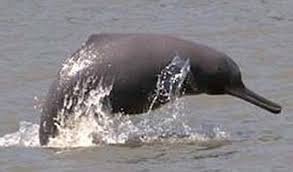Gangetic Dolphin Population Surges to Over 4000 in India
The Wildlife Institute of India recently reported a significant increase in the Gangetic dolphin population, surpassing 4000 individuals in the Gangetic River basin. This positive trend is particularly notable in Uttar Pradesh, where over 2000 dolphins reside, primarily in the Chambal River. This growth highlights successful conservation efforts and improving river health.
The Gangetic Dolphin: An Overview
The Gangetic dolphin, scientifically named Platanista gangetica, is a freshwater species unique to the river systems of India, Nepal, and Bangladesh. Known as the blind dolphin due to its poor eyesight, it relies on echolocation to hunt and navigate. These dolphins produce a distinctive ‘susu’ sound when exhaling and are typically found alone or in small groups.
Conservation Efforts Bearing Fruit
The increase in the Gangetic dolphin population can be attributed to several government initiatives. The species is protected under Schedule I of the Wildlife (Protection) Act, 1972, and was declared the National Aquatic Animal of India in 2010. The establishment of sanctuaries, such as the Vikramshila Dolphin Sanctuary in Bihar, and the launch of Project Dolphin in 2019, have been crucial in these conservation efforts.
Threats and Challenges
Despite the positive trend, Gangetic dolphins face significant threats. Accidental entanglement in fishing gear, poaching for their oil, and habitat destruction due to pollution and development projects continue to pose risks. Efforts to mitigate these threats include stricter enforcement of legal protections and ongoing habitat restoration projects.
Role of the Wildlife Institute of India
Established in 1982, the Wildlife Institute of India has been instrumental in training personnel, conducting research, and advising on wildlife conservation. Headquartered in Dehradun, Uttarakhand, the institute plays a vital role in the conservation of the Gangetic dolphin and other endangered species across India.

Why This News Is Important
Highlighting Conservation Success
The report on the increased Gangetic dolphin population is a testament to successful conservation strategies and improved river health. It showcases the effectiveness of legal protections and habitat restoration initiatives, serving as a model for similar efforts globally.
Raising Awareness
This news brings attention to the Gangetic dolphin, a species often overshadowed by more charismatic wildlife. By highlighting their plight and the measures taken to protect them, it encourages public support and awareness for freshwater conservation efforts.
Policy Implications
The positive results of the conservation efforts may influence future policy decisions. Continued government support and funding are crucial for maintaining and expanding these programs, ensuring the long-term survival of the Gangetic dolphin and other endangered species.
Historical Context
Decline and Conservation Efforts
Historically, the Gangetic dolphin population faced a severe decline due to extensive habitat degradation and poaching. Recognizing the urgent need for conservation, the Indian government implemented several measures, including legal protections under the Wildlife (Protection) Act of 1972 and the declaration of the species as the National Aquatic Animal in 2010. These steps, along with the establishment of sanctuaries and targeted projects like Project Dolphin, have played a significant role in reversing the decline.
International Collaboration
The conservation of the Gangetic dolphin is not limited to India. International collaboration with Nepal and Bangladesh, through shared river systems, is essential for comprehensive conservation strategies. Efforts to synchronize policies and conservation activities across borders are ongoing and critical for the species’ survival.
Key Takeaways from Gangetic Dolphin Population Surge
| Serial Number | Key Takeaway |
|---|---|
| 1 | Over 4000 Gangetic dolphins now inhabit India’s rivers. |
| 2 | Uttar Pradesh is home to more than 2000 dolphins, primarily in the Chambal River. |
| 3 | Conservation efforts include legal protections and the establishment of sanctuaries. |
| 4 | Major threats to dolphins include entanglement in fishing gear and habitat destruction. |
| 5 | The Wildlife Institute of India plays a crucial role in research and conservation initiatives. |
Important FAQs for Students from this News
Q1: What is the current population of Gangetic dolphins in India?
A: The current population of Gangetic dolphins in India is over 4000.
Q2: Which river in Uttar Pradesh has the highest number of Gangetic dolphins?
A: The Chambal River in Uttar Pradesh has the highest number of Gangetic dolphins.
Q3: What is the significance of the Gangetic dolphin in India?
A: The Gangetic dolphin is the National Aquatic Animal of India and is protected under Schedule I of the Wildlife (Protection) Act, 1972.
Q4: What major threats do Gangetic dolphins face?
A: Major threats include entanglement in fishing gear, poaching for oil, and habitat destruction due to pollution and development projects.
Q5: Which organization reported the increase in the Gangetic dolphin population?
A: The Wildlife Institute of India reported the increase in the Gangetic dolphin population.
Some Important Current Affairs Links
















